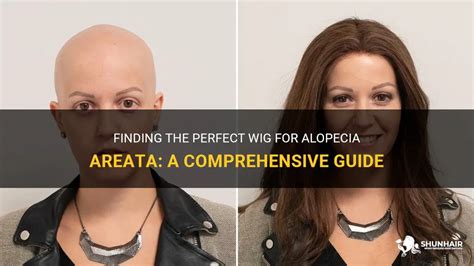Alopecia is a condition that causes hair loss, affecting millions of people worldwide. While there are various treatments available for alopecia, many individuals turn to wigs as a way to regain their confidence and self-esteem. This article provides a comprehensive guide to wigs for alopecia, exploring the different types, benefits, and considerations.

Types of Wigs for Alopecia
1. Human Hair Wigs
- Made from real human hair
- Offer the most natural look and feel
- Can be styled and colored like your own hair
- Relatively expensive
2. Synthetic Hair Wigs
- Made from synthetic fibers
- More affordable than human hair wigs
- Available in a wide range of colors and styles
- Can be more prone to tangling and matting
3. Monofilament Wigs
- Made with a sheer fabric base that creates the illusion of a natural scalp
- Comfortable to wear
- Allows for more natural hair growth and movement
4. Lace Front Wigs
- Feature a lace front that mimics the natural hairline
- Provides a seamless and realistic look
- Can be more expensive and require professional installation
5. Clip-In Wigs
- Attached to natural hair using clips
- Offer temporary hair augmentation
- Easy to remove and store
Benefits of Wigs for Alopecia
- Enhance Appearance: Wigs can instantly improve one’s appearance and boost self-confidence.
- Protect Scalp: For individuals with alopecia areata, wigs can provide protection to the sensitive scalp.
- Reduce Stress: Wearing a wig can alleviate stress and anxiety associated with hair loss.
- Versatility: Wigs allow individuals to experiment with different styles and colors, providing a sense of individuality.
Considerations for Choosing a Wig for Alopecia
1. Hair Type
- Determine if you prefer human hair or synthetic hair wigs, considering factors such as budget and desired look.
2. Cap Construction
- Choose a cap construction that offers comfort and a natural appearance, such as monofilament or lace front wigs.
3. Color and Style
- Select a wig that matches your natural hair color and style or explore different options to enhance your look.
4. Fit and Comfort
- Ensure that the wig fits comfortably and securely, preventing slippage or irritation.
5. Customization
- Consider customizing the wig to meet your specific needs, such as trimming the length or adding highlights.
Pain Points of Individuals with Alopecia
- Dealing with stigma and discrimination
- Experiencing emotional distress and isolation
- Difficulty finding wigs that meet their unique needs
- Feeling self-conscious and insecure about their appearance
Motivations of Individuals with Alopecia
- Seeking improved self-esteem and confidence
- Regaining a sense of control over their appearance
- Feeling supported and connected with others facing similar challenges
- Exploring new opportunities and embracing their individuality
Comparison of Pros and Cons
Human Hair Wigs
Pros:
- Natural look and feel
- Can be styled and colored like natural hair
Cons:
- Expensive
- Requires more care and maintenance
Synthetic Hair Wigs
Pros:
- Affordable
- Available in a wide range of colors and styles
Cons:
- Less natural appearance
- Can be more prone to tangling and matting
Monofilament Wigs
Pros:
- Comfortable to wear
- Natural hair growth and movement
Cons:
- Can be more fragile
- Requires careful handling
Lace Front Wigs
Pros:
- Seamless and realistic look
- Variety of styling options
Cons:
- Expensive
- Requires professional installation
Table 1: Types of Wigs for Alopecia
| Type | Construction | Benefits |
|---|---|---|
| Human Hair | 100% human hair | Natural look and feel, versatile styling |
| Synthetic Hair | Synthetic fibers | Affordable, wide range of colors and styles |
| Monofilament | Sheer fabric base | Comfortable, natural hair growth and movement |
| Lace Front | Lace front mimicking the hairline | Seamless and realistic look, variety of styling options |
| Clip-In | Attached with clips | Temporary hair augmentation, easy to remove |
Table 2: Benefits of Wigs for Alopecia
| Benefit | Impact |
|---|---|
| Enhanced Appearance | Increased self-confidence, reduced stigma |
| Protection | Shields sensitive scalp from UV rays and other elements |
| Stress Reduction | Alleviates anxiety and stress associated with hair loss |
| Versatility | Experimentation with different styles and colors, enhancing individuality |
Table 3: Considerations for Choosing a Wig for Alopecia
| Factor | Description |
|---|---|
| Hair Type | Human hair or synthetic hair, depending on budget and desired look |
| Cap Construction | Monofilament, lace front, or other constructions for comfort and natural appearance |
| Color and Style | Matching natural hair or exploring new options for enhanced style |
| Fit and Comfort | Secure and comfortable fit to prevent slippage or irritation |
| Customization | Trimming, adding highlights, or other modifications to suit specific needs |
Table 4: Pain Points of Individuals with Alopecia
| Pain Point | Impact |
|---|---|
| Stigma and Discrimination | Social isolation, reduced self-esteem |
| Emotional Distress | Feelings of shame, anxiety, and depression |
| Difficulty Finding Wigs | Limited options that meet unique needs |
| Self-Consciousness | Negative self-image, reluctance to participate in social activities |
